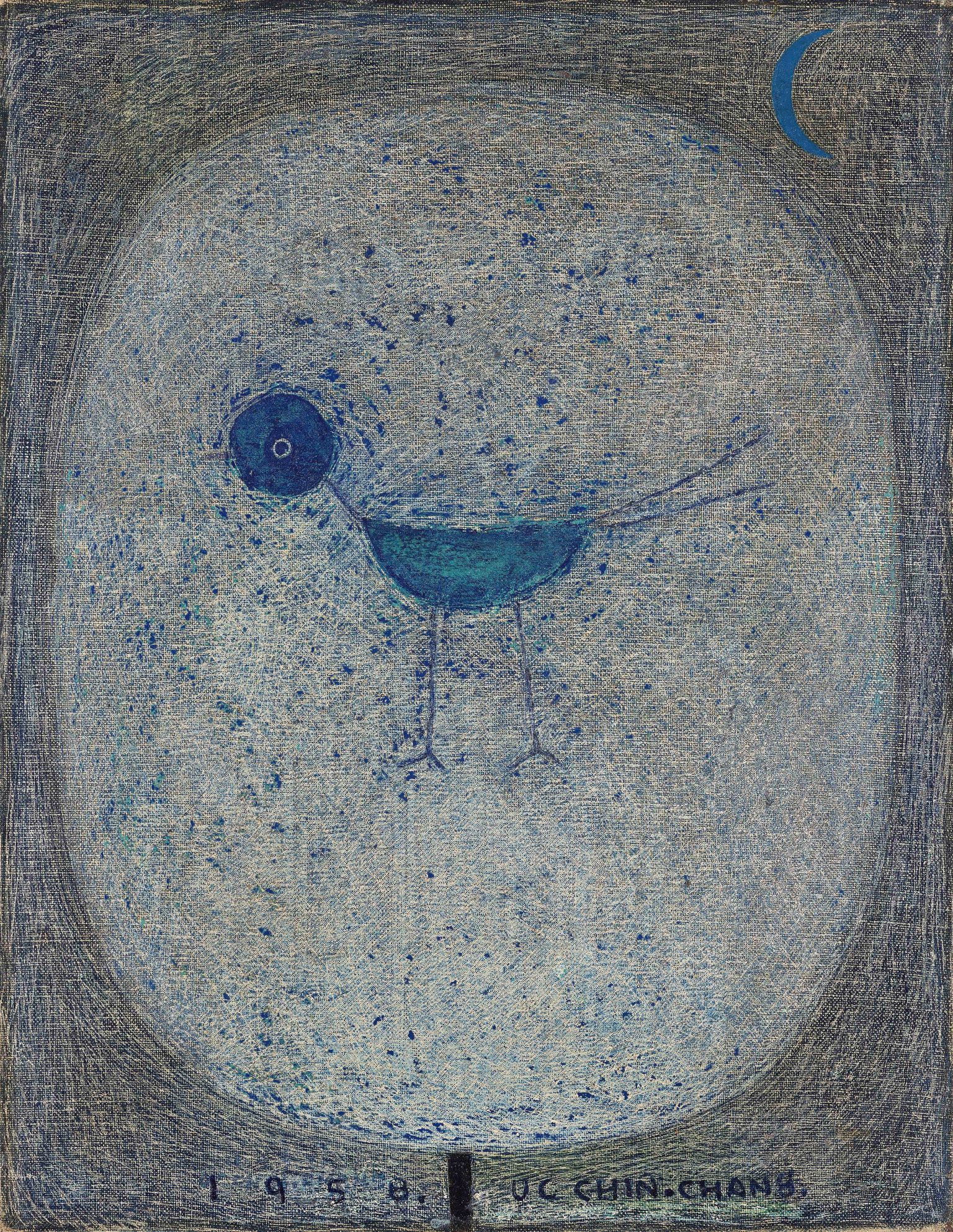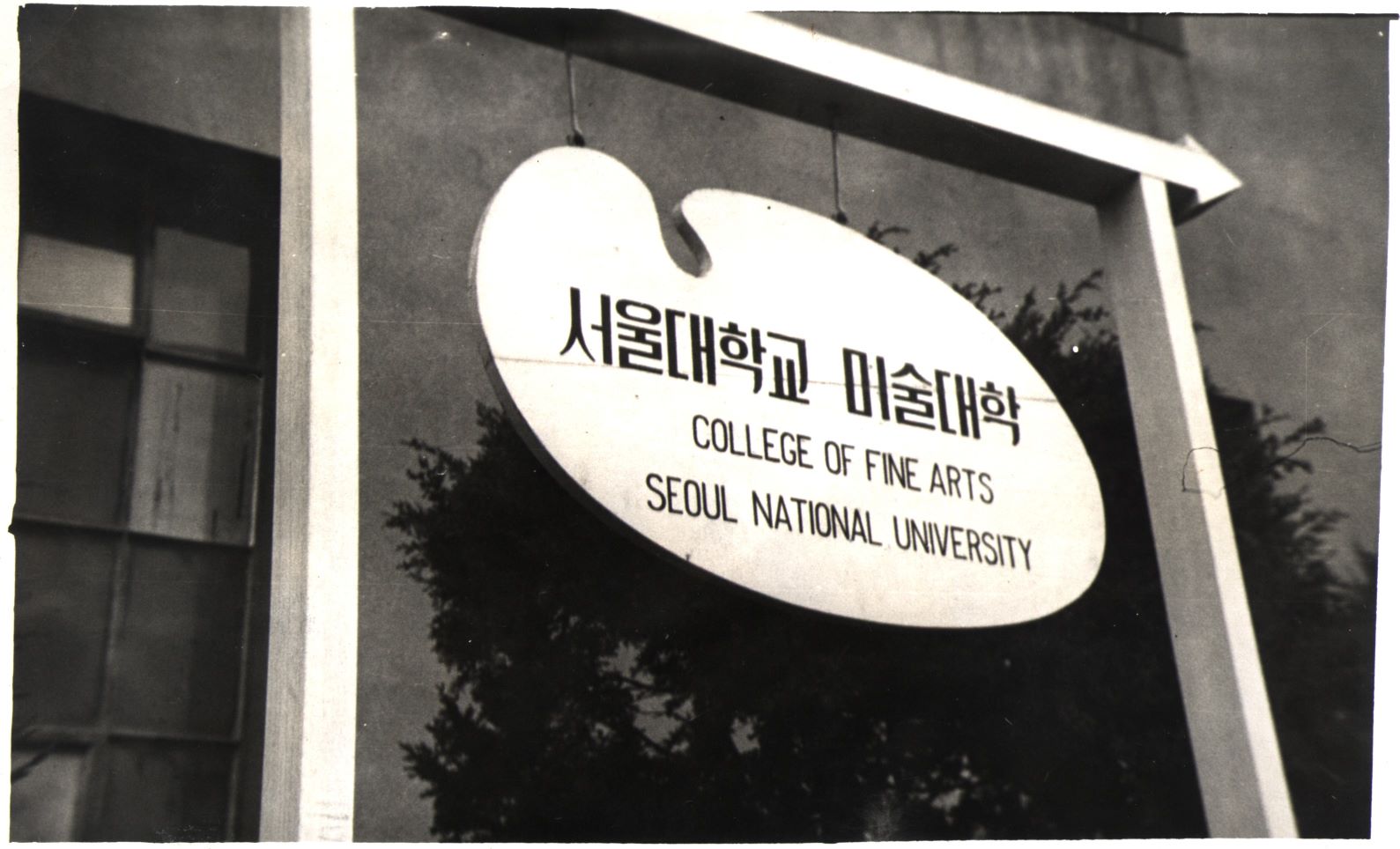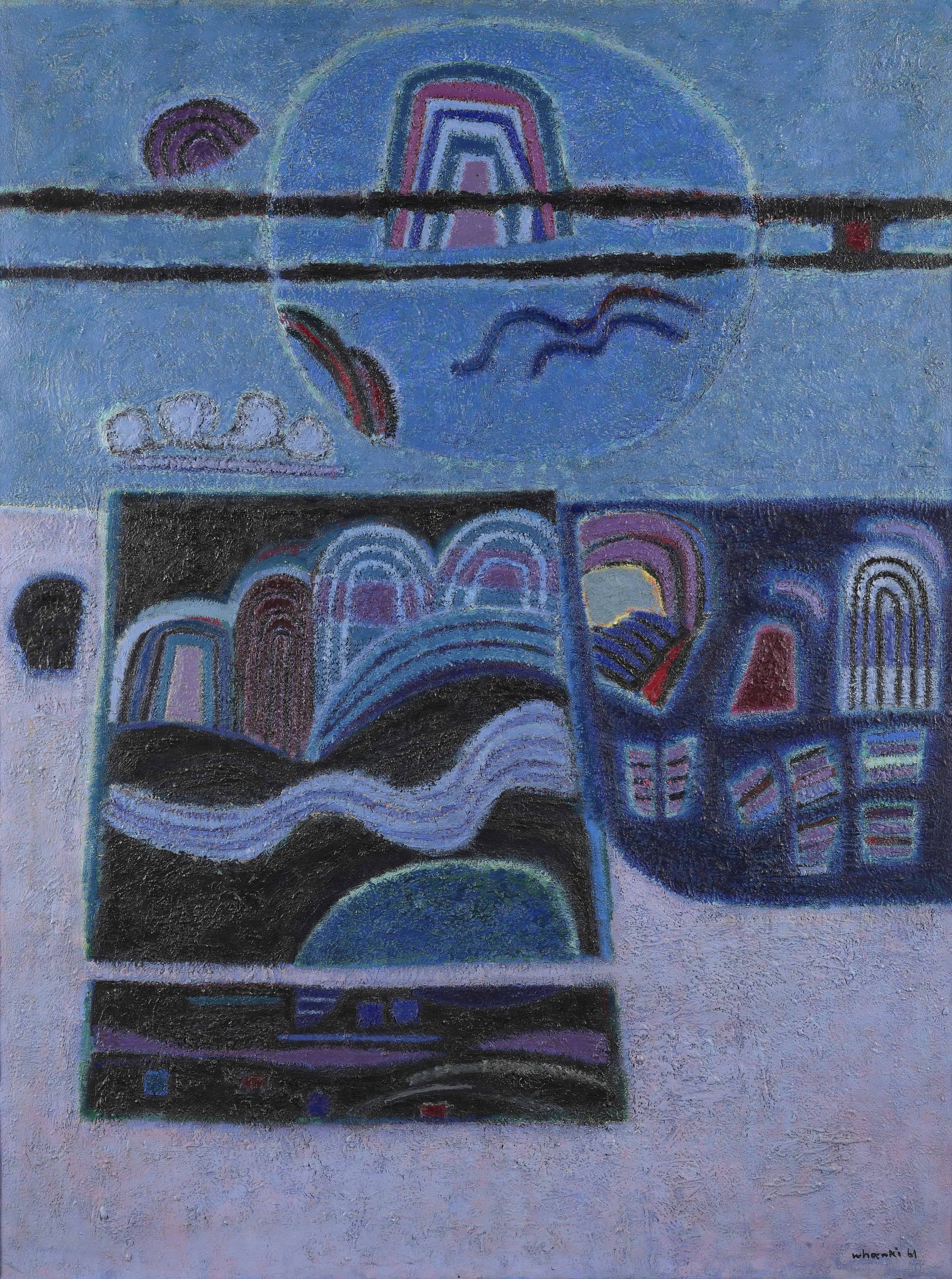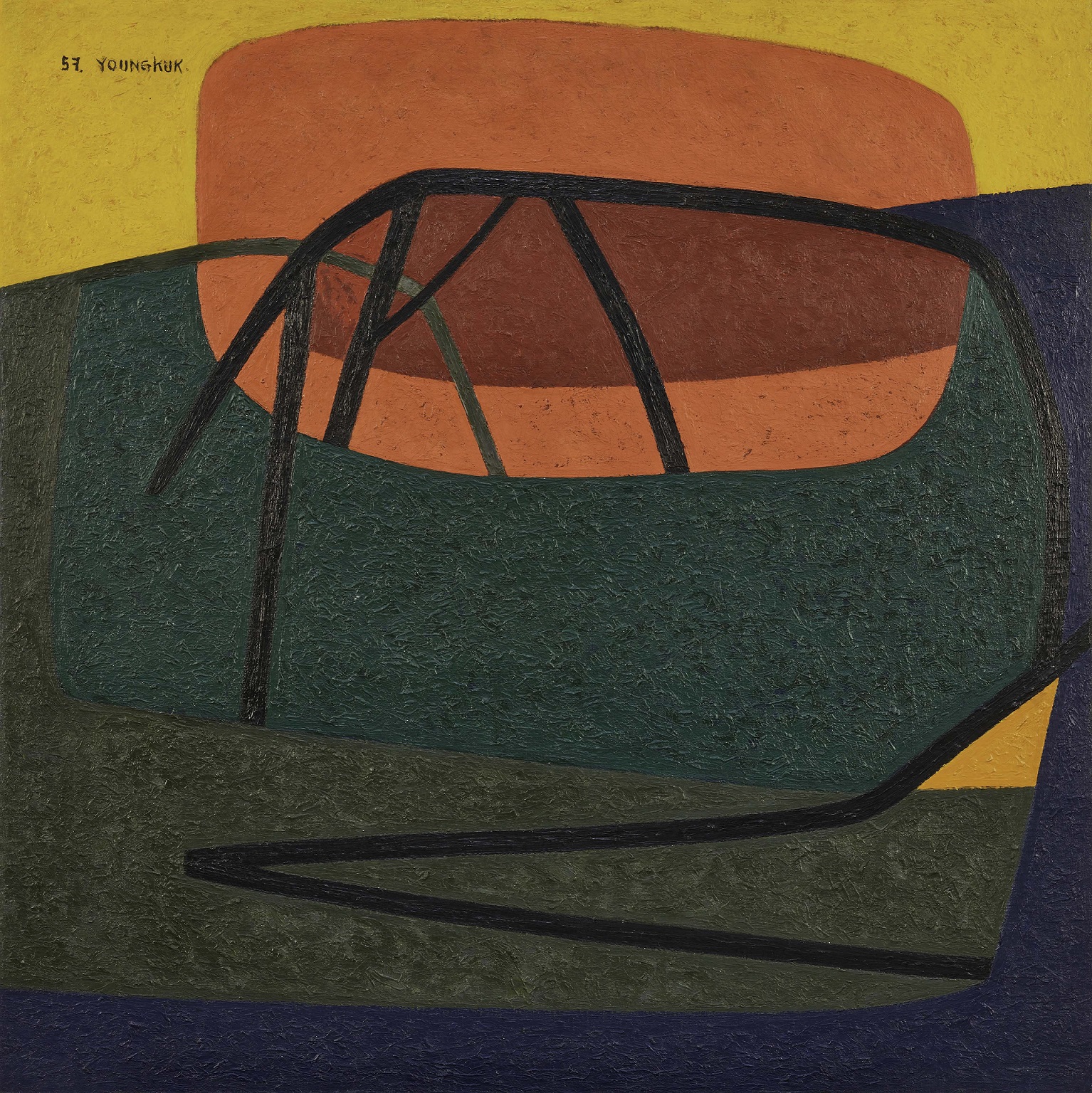
Chang Ucchin, Magpie, 1958, Oil on canvas, 40×31cm. MMCA collection
Chang Ucchin
* Source: Multilingual Glossary of Korean Art. Korea Arts Management Service
Related
-

New Realism Group
The New Realism Group [Sinsasilpa] was a group of abstract artists, such as Kim Whanki, Yoo Youngkuk, and Lee Kyusang, who, through their work sought to represent the conceptualization of a pure Plasticism. One of the most influential groups in Korean modern art, the name “New Realism Group” was created by Kim Whanki. This originated from his foundational idea that the artists of the group should pursue new types of realistic painting. Since they considered that all forms, including abstract ones, ultimately belong to experiential reality, the ambition of the group was to contribute to the perception of a “new formation of reality”. Their inaugural exhibition was held at Hwashin Department Store's gallery from December 7th to 14th, 1948. Chang Ucchin then joined the group for the second exhibition, followed by Lee Jungseop and Paek Youngsu for the third. They disbanded the group after the third exhibition, which was staged at the temporarily relocated National Museum in Busan from May 26th to June 4th, 1953. The works of the New Realism Group navigated a path between figuration and non-figuration through the deployment of abstract expressionist idioms, while also making use of visual elements taken from nature, everyday life, and real-life materials. The New Realism Group were pioneers of a new style of Korean abstract art, one which they realized as an attempt to create a new artistic perspective that could exist outside the pervasive right-left ideological struggle that defined the politically, economically, socially, and culturally unstable Cold War period of Korea. A retrospective exhibition for the group was held at the Won Gallery from September 23rd to 30th, 1978, and a sixtieth commemorative exhibition was held at the Whanki Museum from November 9th in 2007 to January 13th, 2008.
-

College of Arts at Seoul National University
The College of Fine Arts of Seoul National University is located in Sillim-dong, Gwanak-gu, Seoul. According to the Decree on the Establishment of Seoul National University, the College of Art including the Department of Fine Arts and the Department of Music was founded in August 1946 at Seoul National University. The Department of Fine Arts consisted of sub-departments of Painting I, Painting II, Sculpture, and Design. It was organized by Chang Louis Pal and Lee Soonsuk. Chang Louis Pal had served as head of the Education and Management Bureau in the U.S. Army Military Government in Korea (USAMGIK) in Korea since December 1945. Lee Soonsuk assumed practical tasks as an advisor to the art section of the USAMGIK from 1946 when the Education and Management Bureau was changed to the Ministry of Culture and Education. In 1946, there were nine faculty members at the Department of Fine Arts in the College of Art: Chang Louis Pal, Kim Yongjun, Gil Jinseop, and Lee Jaehun as professors; Yun Seung-uk and Lee Soonsuk as associate professors; and Kim Whanki, Chang Woosoung, and Lee Byeonghyeon as assistant professors. However, after the incident of Korean students and professors’ protest against the U.S.’s attempt to merge several colleges and universities into a single university, Kim Yongjun, Gil Jinseop, and Kim Whanki resigned. In 1954, the College of Art was reorganized into the College of Fine Arts with three departments of painting, sculpture, and applied art. The Department of Aesthetics, which had temporarily belonged to the College of Fine Arts since 1948, was transferred to the College of Liberal Arts and Sciences in 1960. In 1963, according to the relocation plan of the Seoul National University main school building, the College of Fine Arts was moved to the former veterinary department building in Yeongeon-dong, Jongno-gu. In 1972, it was moved to the liberal arts department building in Hagye-dong, Seongbuk-gu, and then in 1976, to the current Gwanak campus. In 1981, the three departments of painting, sculpture, and applied art were reorganized into the five departments of Eastern painting, Western painting, sculpture, crafts, and industrial art. In 1989, the Department of Industrial Art was renamed the Department of Industrial Design, and in 1999, the Department of Crafts and the Department of Industrial Design were merged into the School of Design. Currently, the College of Fine Arts consists of the Department of Oriental Painting, Department of Painting, Department of Sculpture, Department of Craft, Department of Design, and Interdisciplinary Programs.
Find More
-

Baeku Association
Baeku Association [Baeguhoe] was an organization founded in July 1955 by artists who graduated from the Imperial Academy of Fine Arts (Teikoku bijutsuin bijutsu tenranka) in Japan. With Kim Man-hyeong, Lee Qoede, Chu Kyung, Hong Ilpyo, and others as leading figures, the association was formed to succeed the Imperial Academy of Fine Arts Alumni Exhibition from 1942, promote friendship among alumni, and present their works. At the time of its founding, the representative members were Chu Kyung, Kim Won, Byeon Huicheon, and Chang Ucchin. Thirty-two artists including Lee Yootae and Kim Hwakyung joined the association. In November 1955, the First Baeku Association Exhibition was held at Deoksugung Museum of Art. Until the fifth edition, the member exhibition was held every year, but from the sixth edition, it was held every other year. The number of members of the Baeku Association grew steadily, reaching forty-two by 1963. However, the cohesion of the members gradually weakened, leading to the discontinuation of the association with the eighth exhibition in 1965 as the final edition.
-

Kim Whanki
Kim Whanki (1913-1974, pen name Suhwa) was born in Sinan, Jeollanamdo, and his family origin was from Gimhae. He studied at the Department of Fine Arts at Nihon University, Tokyo, Japan from 1933 to 1936. He joined the Avant-Garde Western Art Institute in 1934 and submitted his work to Avant-Garde art associations, such as the Second Division Exhibition Nikaten (Nika Art Exhibition) and the Exhibition of the Free Artists Association (Jiyu Bijutsuka Kyokai). After independence, he organized the New Realism Group and worked as a professor in the Department of Fine Art at Seoul National University (1946-1950) and Hongik University (1952-55). He lived in Paris from 1956 to 1959, and after his return, he became a professor and later the Dean of the Fine Art College at Hongik University (1959-1963). He participated in the seventh Sao Paulo Biennale and won an honorary award, and then moved to New York. He abruptly passed away while having a solo exhibition at Poindexter Gallery, New York, ironically when his career in the US was at its peak. As a pioneer of Korean abstract art, he started by working in geometric abstraction and moved on to semi-abstract work that featured natural motifs such as the mountain, the moon, and the river. After moving to the U.S., he returned to abstraction with his so-called "dot paintings." His painting 16-Ⅳ-70 #166 Where, in What Form, Shall We Meet Again? (1970), was awarded a grand prize at the Korean Art Grand Award Exhibition and has inspired many contemporary Korean artists. His work Rondo (1938) was selected as No. 535 within the national Registered Cultural Properties.
-

Yoo Youngkuk
Yoo Youngkuk (1916-2002) was born in Uljin, Gyeongsangbuk-do. He graduated from Uljin Elementary School and attended Gyeongseon Teachers College from 1931 to 1934. He moved to Japan in 1935 and graduated from the Tokyo Culture School in 1938. He submitted his work to the Yanghwa Art Coterie Exhibition and won a grand prize for his radical and avant-garde constructive abstract art in the Free Artists Association Exhibition in 1938. He was then recommended as a new member. After independence, he participated in the New Realism Group Exhibition, the Modern Art Association Exhibition, the 1950 Art Association [Osimnyeon misul hyeophoe] Exhibition, the Contemporary Art Exhibit sponsored by Chosun Ilbo, and Sinsanghoe. He worked as an art professor at Seoul National University from 1948 to 1950 and at Hongik University from 1966 to 1970. He was one of the first abstract artists in Korea. While in Japan he pursued the creation of an absolute form of abstraction. Then, back in Korea after independence, he switched to using constructive and emotional color in his abstract compositions to represent the sublime character of nature.






